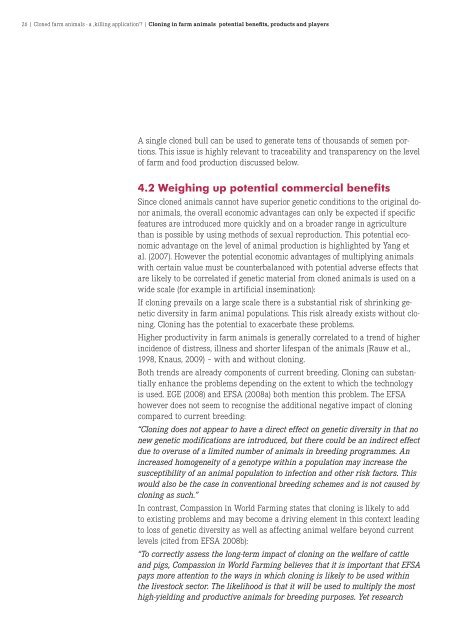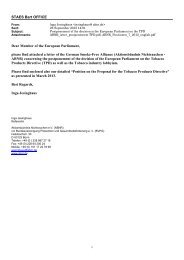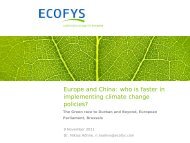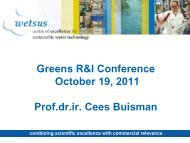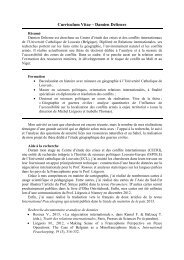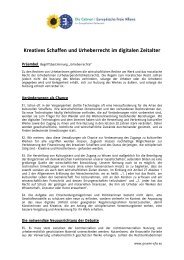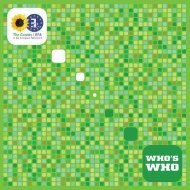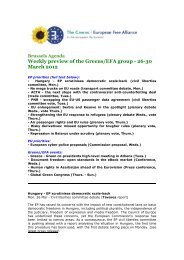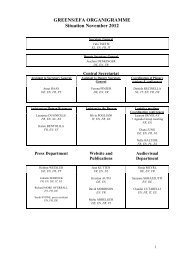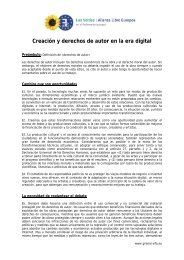Agro-Biotechnology: - The Greens | European Free Alliance
Agro-Biotechnology: - The Greens | European Free Alliance
Agro-Biotechnology: - The Greens | European Free Alliance
Create successful ePaper yourself
Turn your PDF publications into a flip-book with our unique Google optimized e-Paper software.
26 | Cloned farm animals - a ‚killing application‘? | Cloning in farm animals potential benefits, products and players<br />
A single cloned bull can be used to generate tens of thousands of semen portions.<br />
This issue is highly relevant to traceability and transparency on the level<br />
of farm and food production discussed below.<br />
4.2 Weighing up potential commercial benefits<br />
Since cloned animals cannot have superior genetic conditions to the original donor<br />
animals, the overall economic advantages can only be expected if specific<br />
features are introduced more quickly and on a broader range in agriculture<br />
than is possible by using methods of sexual reproduction. This potential economic<br />
advantage on the level of animal production is highlighted by Yang et<br />
al. (2007). However the potential economic advantages of multiplying animals<br />
with certain value must be counterbalanced with potential adverse effects that<br />
are likely to be correlated if genetic material from cloned animals is used on a<br />
wide scale (for example in artificial insemination):<br />
If cloning prevails on a large scale there is a substantial risk of shrinking genetic<br />
diversity in farm animal populations. This risk already exists without cloning.<br />
Cloning has the potential to exacerbate these problems.<br />
Higher productivity in farm animals is generally correlated to a trend of higher<br />
incidence of distress, illness and shorter lifespan of the animals (Rauw et al.,<br />
1998, Knaus, 2009) – with and without cloning.<br />
Both trends are already components of current breeding. Cloning can substantially<br />
enhance the problems depending on the extent to which the technology<br />
is used. EGE (2008) and EFSA (2008a) both mention this problem. <strong>The</strong> EFSA<br />
however does not seem to recognise the additional negative impact of cloning<br />
compared to current breeding:<br />
“Cloning does not appear to have a direct effect on genetic diversity in that no<br />
new genetic modifications are introduced, but there could be an indirect effect<br />
due to overuse of a limited number of animals in breeding programmes. An<br />
increased homogeneity of a genotype within a population may increase the<br />
susceptibility of an animal population to infection and other risk factors. This<br />
would also be the case in conventional breeding schemes and is not caused by<br />
cloning as such.”<br />
In contrast, Compassion in World Farming states that cloning is likely to add<br />
to existing problems and may become a driving element in this context leading<br />
to loss of genetic diversity as well as affecting animal welfare beyond current<br />
levels (cited from EFSA 2008b):<br />
“To correctly assess the long-term impact of cloning on the welfare of cattle<br />
and pigs, Compassion in World Farming believes that it is important that EFSA<br />
pays more attention to the ways in which cloning is likely to be used within<br />
the livestock sector. <strong>The</strong> likelihood is that it will be used to multiply the most<br />
high-yielding and productive animals for breeding purposes. Yet research


